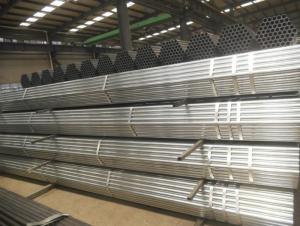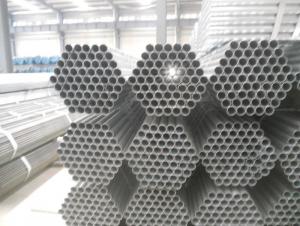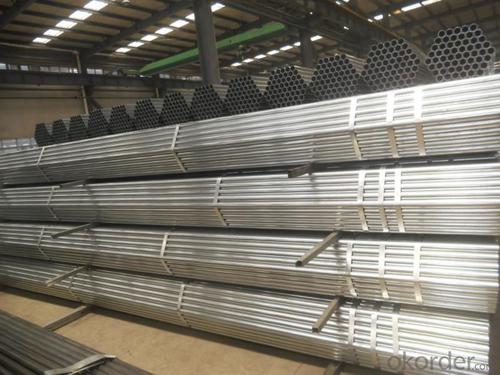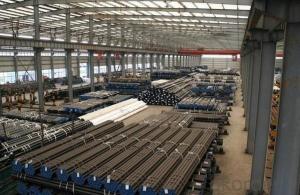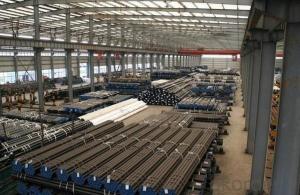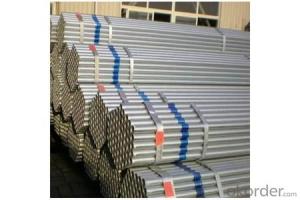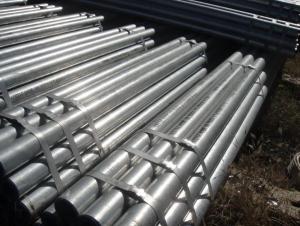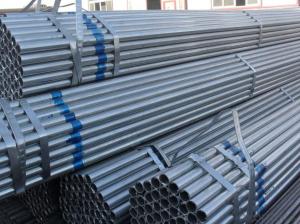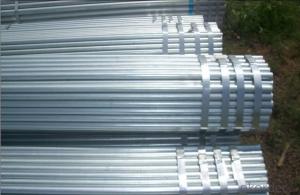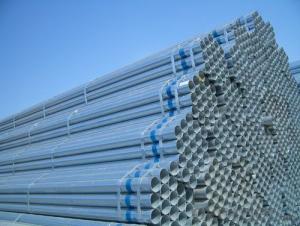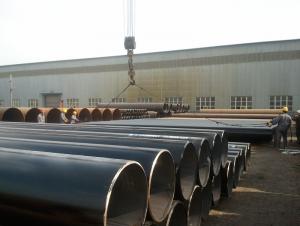ASTM A53 Medium Hot Dipped Galvanized Pipe
- Loading Port:
- Tianjin
- Payment Terms:
- TT or LC
- Min Order Qty:
- 50MT m.t.
- Supply Capability:
- 5000 Tons Per Month m.t./month
OKorder Service Pledge
OKorder Financial Service
You Might Also Like
Application
It is widely used in building, machine, chemical equipment, automobile industrial, container, it is also applied to agriculture and mine machine.
Standard:ASTM A53,BS1387,GB3091
Steel grade: ASTM A53: A, B, C GB3091, BS1387:Q195,Q215,Q235
Thickness of zinc coating: 100g/m2, 120g/m2, 150g/m2, 200g/m2, 250g/m2, 300g/m2, 350g/m2. 400g/m2
Size of Pipe:
OD(MM)
WT(MM) |
21.3 |
26.7 |
33.4 |
42.2 |
48.3 |
60.3 |
73 |
88.9 |
114.3 |
141.3 |
168.3 |
219.1 |
1.70 | √ | √ | √ | √ |
|
|
|
|
|
|
|
|
1.80 | √ | √ | √ | √ |
|
|
|
|
|
|
|
|
1.90 | √ | √ | √ | √ | √ | √ |
|
|
|
|
|
|
2.00 | √ | √ | √ | √ | √ | √ |
|
|
|
|
|
|
2.10 | √ | √ | √ | √ | √ | √ |
|
|
|
|
|
|
2.20 | √ | √ | √ | √ | √ | √ |
|
|
|
|
|
|
2.30 | √ | √ | √ | √ | √ | √ |
|
|
|
|
|
|
2.40 | √ | √ | √ | √ | √ | √ |
|
|
|
|
|
|
2.50 | √ | √ | √ | √ | √ | √ | √ | √ | √ |
| √ |
|
2.75 |
|
| √ | √ | √ | √ | √ | √ | √ | √ | √ | √ |
3.00 |
|
| √ | √ | √ | √ | √ | √ | √ | √ | √ | √ |
3.25 |
|
| √ | √ | √ | √ | √ | √ | √ | √ | √ | √ |
3.50 |
|
|
|
|
| √ | √ | √ | √ | √ | √ | √ |
3.75 |
|
|
|
|
|
| √ | √ | √ | √ | √ | √ |
4.00 |
|
|
|
|
|
|
| √ | √ | √ | √ | √ |
4.25 |
|
|
|
|
|
|
|
|
| √ | √ | √ |
4.50 |
|
|
|
|
|
|
|
|
|
| √ | √ |
4.75 |
|
|
|
|
|
|
|
|
|
|
| √ |
5.00 |
|
|
|
|
|
|
|
|
|
|
| √ |
5.25 |
|
|
|
|
|
|
|
|
|
|
| √ |
ASTM A53
ASTM A53 LIGHT ( HOT DIPPED GALVANIZED PIPES) | ||||||||||||||||
SIZE |
Max |
Min |
Wall Thickness |
Bare Pipes Weight |
Screwed &
Socketed Pipes
Weight | |||||||||||
INCH |
NB(MM) |
mm |
mm |
mm |
kg/m |
kg/m | ||||||||||
1/2" |
15 |
21.4 |
21 |
2 |
0.947 |
0.956 | ||||||||||
3/4" |
20 |
26.9 |
26.4 |
2.3 |
1.38 |
1.39 | ||||||||||
1" |
25 |
33.8 |
33.2 |
2.6 |
1.98 |
2 | ||||||||||
1-1/4" |
32 |
42.5 |
41.9 |
2.6 |
2.54 |
2.57 | ||||||||||
1-1/2" |
40 |
48.4 |
47.8 |
2.9 |
3.23 |
3.27 | ||||||||||
2" |
50 |
60.2 |
59.6 |
2.9 |
4.08 |
4.15 | ||||||||||
2-1/2" |
65 |
76 |
75.2 |
3.2 |
5.71 |
5.83 | ||||||||||
3" |
80 |
88.7 |
87.9 |
3.2 |
6.72 |
6.39 | ||||||||||
3-1/2" |
90 |
113.9 |
113 |
3.6 |
9.75 |
10 | ||||||||||
ASTM A53 MEDIUME ( HOT DIPPED GALVANIZED PIPES) | ||||||||||||||||
SIZE |
Max |
Min |
Wall Thickness |
Bare Pipes Weight |
Screwed &
Socketed
Pipes Weight | |||||||||||
INCH |
NB(MM) |
mm |
mm |
mm |
kg/m |
kg/m | ||||||||||
1/2" |
15 |
21.7 |
21.1 |
2.6 |
1.21 |
1.22 | ||||||||||
3/4" |
20 |
27.2 |
26.6 |
2.6 |
1.54 |
1.57 | ||||||||||
1" |
25 |
34.2 |
33.4 |
3.2 |
2.41 |
2.43 | ||||||||||
1-1/4" |
32 |
42.9 |
42.1 |
3.2 |
3.1 |
3.13 | ||||||||||
1-1/2" |
40 |
48.9 |
48.3 |
3.2 |
3.57 |
3.61 | ||||||||||
2" |
50 |
60.8 |
59.9 |
3.6 |
5.03 |
5.1 | ||||||||||
2-1/2" |
65 |
76.6 |
75.4 |
3.6 |
5.43 |
6.55 | ||||||||||
3" |
80 |
89.5 |
88.1 |
4.5 |
8.37 |
8.54 | ||||||||||
4" |
100 |
114.9 |
113.3 |
4.5 |
12.2 |
12.5 | ||||||||||
5" |
125 |
140.6 |
138.7 |
5 |
15.6 |
17.1 | ||||||||||
6" |
150 |
166.1 |
164.1 |
5 |
19.7 |
20.3 | ||||||||||
ASTM A53 HEAVY ( HOT DIPPED GALVANIZED PIPES) | ||||||||||||||||
SIZE |
Max |
Min |
Wall Thickness |
Bare Pipes Weight |
Screwed &
Socketed
Pipes Weight | |||||||||||
INCH |
NB(MM) |
mm |
mm |
mm |
kg/m |
kg/m | ||||||||||
1/2" |
15 |
21.7 |
21.1 |
3.2 |
1.44 |
1.45 | ||||||||||
3/4" |
20 |
27.2 |
26.6 |
3.2 |
1.87 |
1.88 | ||||||||||
1" |
25 |
34.2 |
33.4 |
4 |
2.94 |
2.96 | ||||||||||
1-1/4" |
32 |
42.9 |
42.1 |
4 |
3.8 |
3.83 | ||||||||||
1-1/2" |
40 |
48.9 |
48.3 |
4 |
4.38 |
4.42 | ||||||||||
2" |
50 |
60.8 |
59.9 |
4.5 |
5.19 |
5.26 | ||||||||||
2-1/2" |
65 |
76.6 |
75.4 |
4.5 |
7.93 |
8.05 | ||||||||||
3" |
80 |
89.5 |
88.1 |
5 |
10.3 |
10.5 | ||||||||||
4" |
100 |
114.9 |
113.3 |
5.4 |
14.5 |
14.9 | ||||||||||
5" |
125 |
140.6 |
138.7 |
5.4 |
17.9 |
18.4 | ||||||||||
6" |
150 |
166.1 |
164.1 |
5.4 |
21.3 |
22.9 | ||||||||||
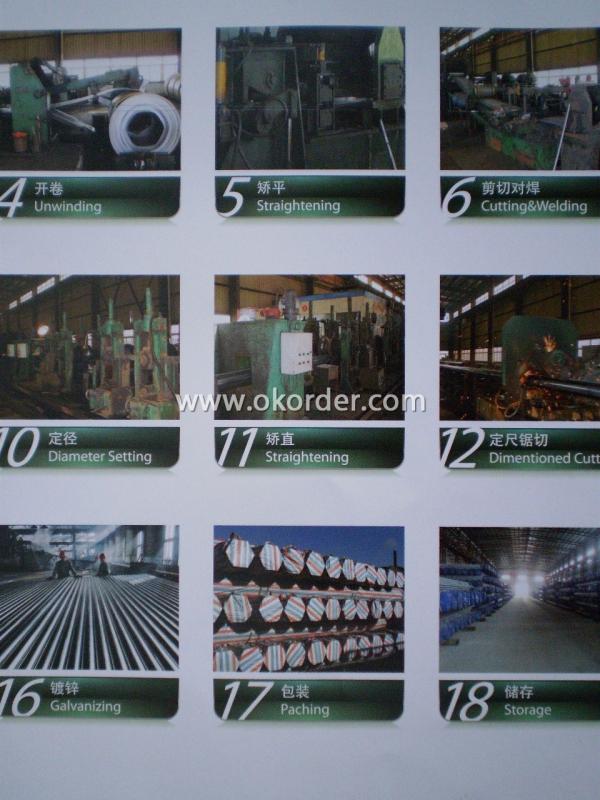
- Q: How are steel pipes used in the construction of telecommunications towers?
- Steel pipes are commonly used in the construction of telecommunications towers as they provide the necessary structural support and stability. These pipes are used for the tower's main framework, ensuring its durability and ability to withstand various environmental conditions. Additionally, steel pipes are also used for cable management, allowing for the safe and efficient installation of telecommunications equipment and cables.
- Q: Can steel pipes be used for underground telecommunications networks?
- Indeed, underground telecommunications networks can utilize steel pipes. The strength, durability, and corrosion resistance of steel pipes make them a prevalent choice for underground applications. These pipes offer both protection and support for telecommunication cables, effectively enduring the pressure and load exerted underground. Moreover, applying protective coatings to steel pipes can augment their corrosion resistance and prolong their lifespan. All in all, steel pipes prove to be a dependable option for underground telecommunications networks.
- Q: Can steel pipes be used for underground gas distribution?
- Yes, steel pipes can be used for underground gas distribution. Steel pipes are commonly used for gas distribution as they are strong, durable, and can withstand high pressure. Additionally, steel pipes have excellent resistance to corrosion, which is crucial for underground installations. However, it is important to ensure proper coating and insulation to prevent any potential damage or leakage.
- Q: What are the environmental impacts of steel pipe production?
- The environmental impacts of steel pipe production include carbon dioxide emissions from the extraction and processing of raw materials, such as iron ore and coal, as well as the energy-intensive manufacturing process. Additionally, the production of steel pipes can contribute to air and water pollution through the release of pollutants and waste materials. The extraction and transportation of raw materials may also result in habitat destruction and disruptions to ecosystems.
- Q: How are steel pipes used in the agriculture industry?
- Steel pipes are widely used in the agriculture industry for various purposes such as irrigation systems, water supply networks, and drainage systems. They are used to transport water for crop irrigation, allowing for efficient and controlled distribution. Steel pipes are also utilized in the construction of farm buildings and structures, providing support and durability. Additionally, they are commonly used in the creation of livestock handling equipment, such as pens and fences. Overall, steel pipes play a crucial role in enhancing productivity and efficiency within the agriculture industry.
- Q: What is the process of coating steel pipes?
- The process of coating steel pipes involves several steps. First, the pipes are cleaned to remove any dirt, rust, or other contaminants. Then, a primer is applied to enhance adhesion and provide a protective layer. Next, the pipes are coated with a specialized coating material, such as epoxy, polyethylene, or zinc, depending on the desired level of corrosion resistance. This coating is applied using various methods, including spraying, dipping, or wrapping. Finally, the coated pipes undergo a curing process, which allows the coating to harden and form a durable barrier against corrosion.
- Q: How are steel pipes protected from corrosion in corrosive environments?
- Steel pipes are protected from corrosion in corrosive environments through various methods such as coating the pipes with corrosion-resistant materials like epoxy or zinc, using cathodic protection techniques, and implementing regular inspections and maintenance to identify and address any potential corrosion issues.
- Q: What are the different types of steel pipe coatings for drinking water pipelines?
- There are several types of steel pipe coatings used for drinking water pipelines, including fusion bonded epoxy (FBE), polyurethane (PU), and polyethylene (PE). These coatings provide corrosion protection, prevent leaching of contaminants into the water, and ensure the durability of the pipes.
- Q: How are steel pipes used in the manufacturing of boilers?
- Steel pipes are an integral component in the manufacturing of boilers due to their strength, durability, and heat-resistant properties. Boilers are used to generate steam or heat water for various industrial and commercial applications. Steel pipes are primarily used in the construction of boiler tubes, which serve as the main heat transfer medium. These tubes are subjected to high temperatures and pressure, making it crucial to use a material that can withstand these extreme conditions. Steel, with its excellent mechanical properties and resistance to corrosion, is the ideal material for this purpose. The manufacturing process of boilers involves forming the steel pipes into specific shapes and sizes to create the boiler tubes. These tubes are then connected to form a network of channels through which hot gases or water flow. The steel pipes used in this process are often seamless or welded, depending on the requirements of the boiler design. The steel pipes used in boilers must meet stringent quality standards to ensure the safety and efficiency of the system. They are tested for their ability to withstand high pressure, temperature, and corrosion. Additionally, they undergo various inspections and tests, such as ultrasonic testing and radiographic examination, to detect any defects or flaws that could compromise the boiler's performance. In summary, steel pipes play a crucial role in the manufacturing of boilers by serving as the primary material for boiler tubes. Their strength, durability, and heat-resistant properties make them suitable for withstanding high temperatures and pressure. These pipes undergo rigorous testing to ensure their quality and reliability in creating efficient and safe boiler systems.
- Q: How can steel pipes be protected from corrosion?
- Steel pipes can be protected from corrosion through various methods. One common method is the application of protective coatings. These coatings act as a barrier between the steel and corrosive elements in the environment. The most widely used protective coating for steel pipes is epoxy, which provides excellent resistance to corrosion. Other coatings such as polyethylene and polyurethane can also be used depending on the specific application and requirements. Another effective way to protect steel pipes from corrosion is by cathodic protection. This technique involves the use of sacrificial anodes or impressed current systems to prevent corrosion. Sacrificial anodes, typically made of zinc or aluminum, are attached to the steel pipes. These anodes corrode instead of the steel, sacrificing themselves to protect the pipes. Impressed current systems, on the other hand, use a direct electrical current to counteract the corrosion process. Regular maintenance and inspection are crucial in the protection of steel pipes from corrosion. Monitoring the condition of the coatings, checking for any signs of damage or deterioration, and promptly addressing any issues can help prevent corrosion from occurring or spreading. Additionally, implementing proper drainage systems to avoid the accumulation of moisture around the pipes can further protect them from corrosion. Lastly, environmental factors should be taken into consideration when protecting steel pipes from corrosion. This includes mitigating exposure to corrosive substances, such as acids or chemicals, and ensuring proper ventilation and airflow to prevent the buildup of moisture and humidity. By implementing a combination of these protective measures, steel pipes can have an extended lifespan and maintain their structural integrity.
1. Manufacturer Overview
| Location | Tianjin, China |
| Year Established | 1999 |
| Annual Output Value | Above Thirty Million RMB |
| Main Markets | Main land; Middle East; Southeast Asia |
| Company Certifications | ISO 9001:2011;CE:2010 |
2. Manufacturer Certificates
| a) Certification Name | |
| Range | |
| Reference | |
| Validity Period |
3. Manufacturer Capability
| a) Trade Capacity | |
| Nearest Port | Tianjin |
| Export Percentage | 30% - 40% |
| No.of Employees in Trade Department | 101-200 People |
| Language Spoken: | English; Chinese |
| b) Factory Information | |
| Factory Size: | 50,000 square meters |
| No. of Production Lines | Above 14 |
| Contract Manufacturing | Hui Ke Steel Pipe Co,.Ltd |
| Product Price Range | Average |
Send your message to us
ASTM A53 Medium Hot Dipped Galvanized Pipe
- Loading Port:
- Tianjin
- Payment Terms:
- TT or LC
- Min Order Qty:
- 50MT m.t.
- Supply Capability:
- 5000 Tons Per Month m.t./month
OKorder Service Pledge
OKorder Financial Service
Similar products
Hot products
Hot Searches
Related keywords
